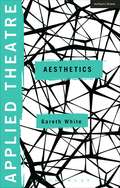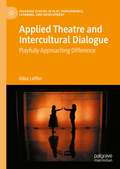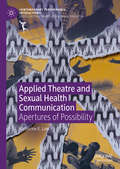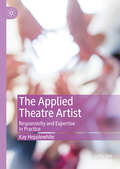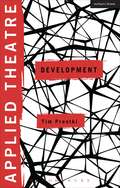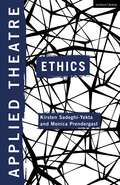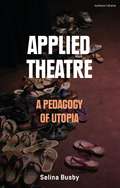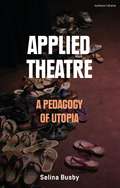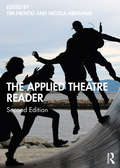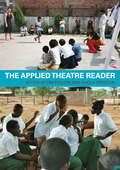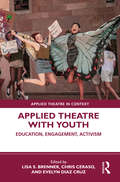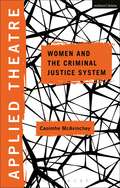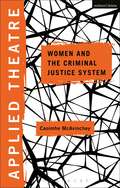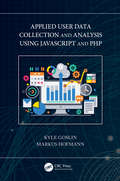- Table View
- List View
Applied Theatre: Aesthetics (Applied Theatre)
by Gareth White Sheila Preston Michael BalfourApplied Theatre: Aesthetics re-examines how the idea of 'the aesthetic' is relevant to performance in social settings. The disinterestedness that traditional aesthetics claims as a key characteristic of art makes little sense when making performances with ordinary people, rooted in their lives and communities, and with personal and social change as its aim. Yet practitioners of applied arts know that their work is not reducible to social work, therapy or education. Reconciling the simultaneous autonomy and heteronomy of art is the problem of aesthetics in applied arts. Gareth White's introductory essay reviews the field, and proposes an interdisciplinary approach that builds on new developments in evolutionary, cognitive and neuro-aesthetics alongside the politics of art. It addresses the complexities of art and the aesthetic as everyday behaviours and responses. The second part of the book is made up of essays from leading experts and new voices in the practice and theory of applied performance, reflecting on the key problematics of applying performance with non-performers. New and innovative practice is described and interrogated, and fresh thinking is introduced in response to perennial problems.
Applied Theatre: Aesthetics (Applied Theatre)
by Gareth WhiteApplied Theatre: Aesthetics re-examines how the idea of 'the aesthetic' is relevant to performance in social settings. The disinterestedness that traditional aesthetics claims as a key characteristic of art makes little sense when making performances with ordinary people, rooted in their lives and communities, and with personal and social change as its aim. Yet practitioners of applied arts know that their work is not reducible to social work, therapy or education. Reconciling the simultaneous autonomy and heteronomy of art is the problem of aesthetics in applied arts. Gareth White's introductory essay reviews the field, and proposes an interdisciplinary approach that builds on new developments in evolutionary, cognitive and neuro-aesthetics alongside the politics of art. It addresses the complexities of art and the aesthetic as everyday behaviours and responses. The second part of the book is made up of essays from leading experts and new voices in the practice and theory of applied performance, reflecting on the key problematics of applying performance with non-performers. New and innovative practice is described and interrogated, and fresh thinking is introduced in response to perennial problems.
Applied Theatre and Intercultural Dialogue: Playfully Approaching Difference (Palgrave Studies In Play, Performance, Learning, and Development)
by Elliot LefflerThis book examines applied theatre projects that bring together diverse groups and foster intercultural dialogue. Based on five case studies and informed by play theory, it argues that the playful elements of theatre processes nurture a unique intimacy among diverse people. However, this playful quality can also dampen explicit conversations about participants’ cultural differences, and defer an interrogation of people’s own entrenchment in systemic power imbalances. As a result, addressing these differences and imbalances in applied theatre contexts may require particular strategies.
Applied Theatre and Sexual Health Communication: Apertures of Possibility (Contemporary Performance InterActions)
by Katharine E. LowThis book analyses the partnership between applied theatre and sexual health communication in a theatre-making project in Nyanga, a township in South Africa. By examining the bridges and schisms between the two fields as they come together in the project, an alternative way of approaching sexual health communication is advocated. This alternative considers what it is that applied theatre does, and could become, in this context. Moments of value which lie around the margins of the practice emerge as opportunities that can be overlooked. These somewhat ephemeral, intangible moments, which appear on the edges, are described as ‘apertures of possibility’ and occur when one takes a step back and realises something unnoticed in the moment. This book offers an invitation to pause and notice the seemingly insignificant moments that often occurs tangentially to the practice. The book also calls for more outcry about sexual health and sexual violence, arguing for theatre-making as a route to multitudes of voices, nuanced understandings, and diverse spaces in which discussions of sexuality and sexual health are shared, felt, and experienced.
Applied Theatre and the Sustainable Development Goals: Crises, Collaboration, and Beyond (ISSN)
by Bobby Smith Taiwo Afolabi Abdul Karim HakibThis book is the first definitive publication to consider the intersections of applied theatre and the Sustainable Development Goals (SDGs) – a series of goals which have shaped development and social justice initiatives from 2015 to 2030.It brings together emerging and leading scholars and practitioners engaged in creative and community contexts globally. In so doing, the book offers critical insights to explore the convergences, complexities, and tensions of working within development frameworks, through theatre. Divided into three thematic areas, it maps out the ways in which applied theatre has related to the SDGs, examines issues with global collaborations, and, as 2030 approaches and the SDG era draws to a close, interrogates such practices, envisioning what the role of applied theatre might be in the post-SDG era. The book provokes reflection about this specific era of applied theatre and global development, as well as discussion regarding what comes next.This volume will be of importance to students, artists, scholars, practitioners, and policymakers working in applied theatre and the field of development.
Applied Theatre and the Sustainable Development Goals: Crises, Collaboration, and Beyond (ISSN)
This book is the first definitive publication to consider the intersections of applied theatre and the Sustainable Development Goals (SDGs) – a series of goals which have shaped development and social justice initiatives from 2015 to 2030.It brings together emerging and leading scholars and practitioners engaged in creative and community contexts globally. In so doing, the book offers critical insights to explore the convergences, complexities, and tensions of working within development frameworks, through theatre. Divided into three thematic areas, it maps out the ways in which applied theatre has related to the SDGs, examines issues with global collaborations, and, as 2030 approaches and the SDG era draws to a close, interrogates such practices, envisioning what the role of applied theatre might be in the post-SDG era. The book provokes reflection about this specific era of applied theatre and global development, as well as discussion regarding what comes next.This volume will be of importance to students, artists, scholars, practitioners, and policymakers working in applied theatre and the field of development.
The Applied Theatre Artist: Responsivity and Expertise in Practice
by Kay HepplewhiteThis book analyses the work of applied theatre practitioners using a new framework of ‘responsivity’ to make visible their unique expertise. In-depth investigation of practice combines with theorisation to provide a fresh view of the work of artists and facilitators. Case studies are drawn from community contexts: with women, mental health service users, refugees, adults with a learning disability, older people in care, and young people in school. Common skills and qualities are given a vocabulary to help define applied theatre work, such as awareness, anticipation, adaptation, attunement, and responsiveness. The Applied Theatre Artist is of scholarly, practical, and educational interest. The book offers detailed analysis of how skilled theatre artists make in-action decisions within socially engaged participatory projects. Rich description of in-session activity reveals what workshop facilitators actually do and how they think, offering a rare focus in applied theatre.
Applied Theatre: Development (Applied Theatre)
by Tim PrentkiAt once both guide book and provocation, this is an indispensable companion for students and practitioners of applied theatre. It addresses all key aspects: principles, origins, politics and aesthetics in a concise and accessible style designed to appeal both to those who have recently discovered this sub-discipline and to experienced practitioners and academics.Part 1 is divided into two chapters. The first introduces the sub-discipline of Theatre for Development, covering its origins, principles and history, and providing an overview of theatre for development in Western contexts as well as in Africa, Asia, the Indian Subcontinent and Latin America. The second focuses upon theoretical and philosophical issues confronting the discipline and its relationship to contemporary politics, as well as considering its future role.Part 2 consists of seven chapters contributed by leading figures and current practitioners from around the world and covering a diverse range of themes, methodologies and aesthetic approaches. One chapter offers a series of case studies concerned with sexual health education and HIV prevention, drawn from practitioners working in Vietnam, Papua New Guinea, Southern Africa, and China. Other chapters include studies of intercultural theatre in the Peruvian Amazon; a programme of applied theatre conducted in schools in Canterbury, New Zealand, following the 2010 earthquake; an attempt to reinvigorate a community theatre group in South Brazil; and an exchange between a Guatemalan arts collective and a Dutch youth theatre company, besides others.
Applied Theatre: Ethics (Applied Theatre)
by Michael BalfourApplied Theatre: Ethics explores what it means for applied theatre practice to be conducted in an ethical way and examines how this affects the work done with communities and participants. It considers how practitioners can balance aesthetics and ethics when creating performance, particularly with relatively inexperienced and often vulnerable groups of people who are being asked to both tell and stage their stories. The two sections bring together theoretical and practical ways for theatre-makers to examine the ethics of their applied theatre projects. Part One offers an overview of critical debates and the editors' reflections on their own practice. It introduces readers to ethics in applied theatre, informed by the thinking of philosophers, scholarly literature and the editors' own experience, including Indigenous perspectives on ethics and theatre. For applied theatre practitioners, it provides recommendations for community-based ethical approaches working with principles of voice, agency, care, service, collaboration, presence, relationality and reciprocity. Part Two presents a range of international case studies that explore how the theories and issues are worked out in a variety of diverse practices. It considers ethics from varying critical perspectives and contexts, including projects in Greece, Nigeria, Sri Lanka, Bangladesh, the United States, the United Kingdom, the Philippines and Canada. Covering work with participants of many ages, the case studies include the work of a professional dance theatre company working with people in substance abuse recovery in the UK, interactive drama used in an educational context in Nigeria, and the complexities around an applied theatre project on race in the US.
Applied Theatre: Ethics (Applied Theatre)
by Michael BalfourApplied Theatre: Ethics explores what it means for applied theatre practice to be conducted in an ethical way and examines how this affects the work done with communities and participants. It considers how practitioners can balance aesthetics and ethics when creating performance, particularly with relatively inexperienced and often vulnerable groups of people who are being asked to both tell and stage their stories. The two sections bring together theoretical and practical ways for theatre-makers to examine the ethics of their applied theatre projects. Part One offers an overview of critical debates and the editors' reflections on their own practice. It introduces readers to ethics in applied theatre, informed by the thinking of philosophers, scholarly literature and the editors' own experience, including Indigenous perspectives on ethics and theatre. For applied theatre practitioners, it provides recommendations for community-based ethical approaches working with principles of voice, agency, care, service, collaboration, presence, relationality and reciprocity. Part Two presents a range of international case studies that explore how the theories and issues are worked out in a variety of diverse practices. It considers ethics from varying critical perspectives and contexts, including projects in Greece, Nigeria, Sri Lanka, Bangladesh, the United States, the United Kingdom, the Philippines and Canada. Covering work with participants of many ages, the case studies include the work of a professional dance theatre company working with people in substance abuse recovery in the UK, interactive drama used in an educational context in Nigeria, and the complexities around an applied theatre project on race in the US.
Applied Theatre: A Pedagogy of Utopia
by Selina BusbyApplied Theatre is a widely accepted term to describe a set of practices that encompass community, social and participatory theatre making. It is an area of performance practice that is flourishing within international contexts and communities. This book offers a critical consideration of long-term applied and participatory theatre projects. In doing so it is a timely analysis of the concepts that inform applied theatre and argues that a number of concepts that form cornerstones of the discipline, have become shibboleths in applied theatre thinking, practice and teaching. The book problematises some of these key concepts, specifically regarding change and transformation, safe spaces, impact, exit strategies, ethical practice, process versus product and the concept of the applied theatre practitioner tool kit. Busby analyses applied theatre projects in India, Malta, New Zealand, the USA and the UK to consider her key question: is the 21st century the end for applied theatre as it was understood to function at the end of the previous century? Drawing on 20 years of practice in prisons, youth theatres and with street and slum-dwellers, this book focuses on long-term interventions that raise troubling questions about applied theatre, cultural colonialism and power, while arguing that community or participatory theatre conversely has the potential to generate a resilient sense of optimism, or what Busby terms a 'nebulous utopia'.
Applied Theatre: A Pedagogy of Utopia
by Selina BusbyApplied Theatre is a widely accepted term to describe a set of practices that encompass community, social and participatory theatre making. It is an area of performance practice that is flourishing within international contexts and communities. This book offers a critical consideration of long-term applied and participatory theatre projects. In doing so it is a timely analysis of the concepts that inform applied theatre and argues that a number of concepts that form cornerstones of the discipline, have become shibboleths in applied theatre thinking, practice and teaching. The book problematises some of these key concepts, specifically regarding change and transformation, safe spaces, impact, exit strategies, ethical practice, process versus product and the concept of the applied theatre practitioner tool kit. Busby analyses applied theatre projects in India, Malta, New Zealand, the USA and the UK to consider her key question: is the 21st century the end for applied theatre as it was understood to function at the end of the previous century? Drawing on 20 years of practice in prisons, youth theatres and with street and slum-dwellers, this book focuses on long-term interventions that raise troubling questions about applied theatre, cultural colonialism and power, while arguing that community or participatory theatre conversely has the potential to generate a resilient sense of optimism, or what Busby terms a 'nebulous utopia'.
The Applied Theatre Reader
by Prentki, Tim / Abraham, NicolaThe Applied Theatre Reader is the first book to bring together new case studies of practice by leading practitioners and academics in the field and beyond, with classic source texts from writers such as Noam Chomsky, bell hooks, Mikhail Bakhtin, Augusto Boal, and Chantal Mouffe. This new edition brings the field fully up to date with the breadth of applied theatre practice in the Twenty First Century, adding essays on playback theatre, digital technology, work with indigenous practitioners, inter-generational practice, school projects, and contributors from South America, Australia and New Zealand. The Reader divides the field into key themes, inviting critical interrogation of issues in applied theatre whilst also acknowledging the multi-disciplinary nature of its subject, crossing fields like theatre in educational settings, prison theatre, community performance, theatre in conflict resolution, interventionist theatre, and theatre for development. A new lexicon of Applied Theatre and further reading for every section will equip readers with the ideal tools for studying this broad and varied field. This collection of critical thought and practice is essential to those studying or participating in the performing arts as a means for positive change.
The Applied Theatre Reader
by Tim Prentki Nicola AbrahamThe Applied Theatre Reader is the first book to bring together new case studies of practice by leading practitioners and academics in the field and beyond, with classic source texts from writers such as Noam Chomsky, bell hooks, Mikhail Bakhtin, Augusto Boal, and Chantal Mouffe. This new edition brings the field fully up to date with the breadth of applied theatre practice in the Twenty First Century, adding essays on playback theatre, digital technology, work with indigenous practitioners, inter-generational practice, school projects, and contributors from South America, Australia and New Zealand. The Reader divides the field into key themes, inviting critical interrogation of issues in applied theatre whilst also acknowledging the multi-disciplinary nature of its subject, crossing fields like theatre in educational settings, prison theatre, community performance, theatre in conflict resolution, interventionist theatre, and theatre for development. A new lexicon of Applied Theatre and further reading for every section will equip readers with the ideal tools for studying this broad and varied field. This collection of critical thought and practice is essential to those studying or participating in the performing arts as a means for positive change.
The Applied Theatre Reader
by Tim Prentki Sheila PrestonThe Applied Theatre Reader is the first book to bring together new case studies of practice by leading practitioners and academics in the field and beyond, with classic source texts from writers such as Noam Chomsky, bell hooks, Mikhail Bakhtin, Augusto Boal, and Chantal Mouffe. This book divides the field into key themes, inviting critical interrogation of issues in applied theatre whilst also acknowledging the multi-disciplinary nature of its subject. It crosses fields such as: theatre in educational settings prison theatre community performance theatre in conflict resolution and reconciliation interventionist theatre theatre for development. This collection of critical thought and practice is essential to those studying or participating in the performing arts as a means for positive change.
The Applied Theatre Reader
by Tim Prentki Sheila PrestonThe Applied Theatre Reader is the first book to bring together new case studies of practice by leading practitioners and academics in the field and beyond, with classic source texts from writers such as Noam Chomsky, bell hooks, Mikhail Bakhtin, Augusto Boal, and Chantal Mouffe. This book divides the field into key themes, inviting critical interrogation of issues in applied theatre whilst also acknowledging the multi-disciplinary nature of its subject. It crosses fields such as: theatre in educational settings prison theatre community performance theatre in conflict resolution and reconciliation interventionist theatre theatre for development. This collection of critical thought and practice is essential to those studying or participating in the performing arts as a means for positive change.
Applied Theatre with Youth: Education, Engagement, Activism (Applied Theatre in Context)
by Lisa S. Brenner Chris Ceraso Evelyn Diaz CruzApplied Theatre with Youth is a collection of essays that highlight the value and efficacy of applied theatre with young people in a broad range of settings, addressing challenges and offering concrete solutions. This book tackles the vital issues of our time—including, among others, racism, climate crisis, gun violence, immigration, and gender—fostering dialogue, promoting education, and inciting social change. The book is divided into thematic sections, each opening with an essay addressing a range of questions about the benefits, challenges, and learning opportunities of a particular type of applied theatre. These are followed by response essays from theatre practitioners, discussing how their own approach aligns with and/or diverges from that of the initial essay. Each section then ends with a moderated roundtable discussion between the essays’ authors, further exploring the themes, issues, and ideas that they have introduced. With its accessible format and clear language, Applied Theatre with Youth is a valuable resource for theatre practitioners and the growing number of theatre companies with education and community engagement programs. Additionally, it provides essential reading for teachers and students in a myriad of fields: education, theatre, civic engagement, criminal justice, sociology, women and gender studies, environmental studies, disability studies, ethnicity and race studies.
Applied Theatre with Youth: Education, Engagement, Activism (Applied Theatre in Context)
by Lisa S. Brenner, Chris Ceraso, and Evelyn Diaz CruzApplied Theatre with Youth is a collection of essays that highlight the value and efficacy of applied theatre with young people in a broad range of settings, addressing challenges and offering concrete solutions. This book tackles the vital issues of our time—including, among others, racism, climate crisis, gun violence, immigration, and gender—fostering dialogue, promoting education, and inciting social change. The book is divided into thematic sections, each opening with an essay addressing a range of questions about the benefits, challenges, and learning opportunities of a particular type of applied theatre. These are followed by response essays from theatre practitioners, discussing how their own approach aligns with and/or diverges from that of the initial essay. Each section then ends with a moderated roundtable discussion between the essays’ authors, further exploring the themes, issues, and ideas that they have introduced. With its accessible format and clear language, Applied Theatre with Youth is a valuable resource for theatre practitioners and the growing number of theatre companies with education and community engagement programs. Additionally, it provides essential reading for teachers and students in a myriad of fields: education, theatre, civic engagement, criminal justice, sociology, women and gender studies, environmental studies, disability studies, ethnicity and race studies.
Applied Theatre: Women and the Criminal Justice System (Applied Theatre)
by Caoimhe McAvincheyApplied Theatre: Women and the Criminal Justice System offers unprecedented access to international theatre and performance practice in carceral contexts and the material and political conditions that shape this work. Each of the twelve essays and interviews by international practitioners and scholars reveal a panoply of practice: from cross-arts projects shaped by autobiographical narratives through to fantasy-informed cabaret; from radio plays to film; from popular participatory performance to work staged in commercial theatres. Extracts of performance texts, developed with Clean Break theatre company, are interwoven through the collection.Television and film images of women in prison are repeatedly painted from a limited palette of stereotypes – 'bad girls', 'monsters', 'babes behind bars'. To attend to theatre with and about women with experience of the criminal justice system is to attend to intersectional injustices that shape women's criminalization and the personal and political implications of this. The theatre and performance practices in this collection disrupt, expand and reframe representational vocabularies of criminalized women for audiences within and beyond prison walls. They expose the role of incarceration as a mechanism of state punishment, the impact of neoliberalism on ideologies of punishment and the inequalities and violence that shape the lives of many incarcerated women. In a context where criminalized women are often dismissed as unreliable or untrustworthy, the collection engages with theatre practices which facilitate an economy of credibility, where women with experience of the criminal justice system are represented as expert witnesses.
Applied Theatre: Women and the Criminal Justice System (Applied Theatre)
by Caoimhe McAvincheyApplied Theatre: Women and the Criminal Justice System offers unprecedented access to international theatre and performance practice in carceral contexts and the material and political conditions that shape this work. Each of the twelve essays and interviews by international practitioners and scholars reveal a panoply of practice: from cross-arts projects shaped by autobiographical narratives through to fantasy-informed cabaret; from radio plays to film; from popular participatory performance to work staged in commercial theatres. Extracts of performance texts, developed with Clean Break theatre company, are interwoven through the collection.Television and film images of women in prison are repeatedly painted from a limited palette of stereotypes – 'bad girls', 'monsters', 'babes behind bars'. To attend to theatre with and about women with experience of the criminal justice system is to attend to intersectional injustices that shape women's criminalization and the personal and political implications of this. The theatre and performance practices in this collection disrupt, expand and reframe representational vocabularies of criminalized women for audiences within and beyond prison walls. They expose the role of incarceration as a mechanism of state punishment, the impact of neoliberalism on ideologies of punishment and the inequalities and violence that shape the lives of many incarcerated women. In a context where criminalized women are often dismissed as unreliable or untrustworthy, the collection engages with theatre practices which facilitate an economy of credibility, where women with experience of the criminal justice system are represented as expert witnesses.
Applied Urban Design: A Contextually Responsive Approach
by Michael Martin Robert Phillips Philip Black Taki SonbliApplied Urban Design combines 'why' we design and 'who' we design for, with 'how' we design, by providing the reader with a comprehensive and accessible bespoke framework for both understanding and practicing urban design in a contextually responsive manner from appraisal to design delivery. The framework is presented across four distinct steps, covering analysis at strategic and local scales; the urban design program; design development; and technical design. The authors unpack the functional blueprints, liveable qualities, contextual dynamics, and technical components of quality urban design, identifying the role of urban designers in shaping spaces and places across differing local contexts through a responsive and multiscalar approach. International best practice examples and two original ‘live’ case studies in Aalborg, Denmark and Manchester, UK demonstrate the application of the framework across differing scales and contexts – each supported by authors own images and graphics that illustrate the broad range of urban design visualisation techniques and methods.Visually compelling and insightful, Applied Urban Design is for all who seek to understand, demand, and create people-centred, high-quality, contextually responsive places and spaces.
Applied Urban Design: A Contextually Responsive Approach
by Michael Martin Robert Phillips Philip Black Taki SonbliApplied Urban Design combines 'why' we design and 'who' we design for, with 'how' we design, by providing the reader with a comprehensive and accessible bespoke framework for both understanding and practicing urban design in a contextually responsive manner from appraisal to design delivery. The framework is presented across four distinct steps, covering analysis at strategic and local scales; the urban design program; design development; and technical design. The authors unpack the functional blueprints, liveable qualities, contextual dynamics, and technical components of quality urban design, identifying the role of urban designers in shaping spaces and places across differing local contexts through a responsive and multiscalar approach. International best practice examples and two original ‘live’ case studies in Aalborg, Denmark and Manchester, UK demonstrate the application of the framework across differing scales and contexts – each supported by authors own images and graphics that illustrate the broad range of urban design visualisation techniques and methods.Visually compelling and insightful, Applied Urban Design is for all who seek to understand, demand, and create people-centred, high-quality, contextually responsive places and spaces.
Applied User Data Collection and Analysis Using JavaScript and PHP
by Kyle Goslin Markus HofmannApplied User Data Collection and Analysis Using JavaScript and PHP is designed to provide the technical skills and competency to gather a wide range of user data from web applications in both active and passive methods. This is done by providing the reader with real-world examples of how a variety of different JavaScript and PHP based libraries can be used to gather data using custom feedback forms and embedded data gathering tools. Once data has been gathered, this book explores the process of working with numerical data, text analysis, visualization approaches, statistics and rolling out developed applications to both data analysists and users alike.Using the collected data, this book aims to provide a deeper understanding of user behavior and interests allowing application developers to further enhance web application development. Key Features: Complete real-world examples of gathering data from users and web environments Offers readers the fundamentals of text analysis using JavaScript and PHP Allows the user to understand and harness JavaScript data visualization tools Integration of new and existing data sources into a single bespoke web-based analysis environment Author Bio: Dr. Kyle Goslin is currently a Lecturer in Computing at the Technological University Dublin in Ireland, specializing in web application development, information retrieval, text analysis and data visualization. Kyle has taught for over 10 years at third level in Ireland, teaching a wide range of web development related subjects. During this time, he has been involved in several different web-based data driven start-up companies with the aim of reducing time to market for businesses. Kyle has contributed to several different open-source learning platforms with the aim of making education accessible to all learners by aiding both teachers and students. Kyle has developed and defended a number of different third level computing courses validated by Quality and Qualifications Ireland. He has published peer-reviewed articles relating to information retrieval, text analysis and learning environments. In his spare time, he is a technical reviewer for data and software development related books. He holds a Bachelor of Science (Honours) and Doctor of Philosophy from the Technological University Dublin, where he currently lectures and lives. For more information, visit www.kylegoslin.ie Dr. Markus Hofmann is currently Senior Lecturer at the Technological University Dublin in Ireland where he focuses on the areas of data mining, text mining, data exploration and visualization as well as business intelligence. He holds a Ph.D. from Trinity College Dublin, an MSc in Computing (Information Technology for Strategic Management) from the Dublin Institute
Applied User Data Collection and Analysis Using JavaScript and PHP
by Kyle Goslin Markus HofmannApplied User Data Collection and Analysis Using JavaScript and PHP is designed to provide the technical skills and competency to gather a wide range of user data from web applications in both active and passive methods. This is done by providing the reader with real-world examples of how a variety of different JavaScript and PHP based libraries can be used to gather data using custom feedback forms and embedded data gathering tools. Once data has been gathered, this book explores the process of working with numerical data, text analysis, visualization approaches, statistics and rolling out developed applications to both data analysists and users alike.Using the collected data, this book aims to provide a deeper understanding of user behavior and interests allowing application developers to further enhance web application development. Key Features: Complete real-world examples of gathering data from users and web environments Offers readers the fundamentals of text analysis using JavaScript and PHP Allows the user to understand and harness JavaScript data visualization tools Integration of new and existing data sources into a single bespoke web-based analysis environment Author Bio: Dr. Kyle Goslin is currently a Lecturer in Computing at the Technological University Dublin in Ireland, specializing in web application development, information retrieval, text analysis and data visualization. Kyle has taught for over 10 years at third level in Ireland, teaching a wide range of web development related subjects. During this time, he has been involved in several different web-based data driven start-up companies with the aim of reducing time to market for businesses. Kyle has contributed to several different open-source learning platforms with the aim of making education accessible to all learners by aiding both teachers and students. Kyle has developed and defended a number of different third level computing courses validated by Quality and Qualifications Ireland. He has published peer-reviewed articles relating to information retrieval, text analysis and learning environments. In his spare time, he is a technical reviewer for data and software development related books. He holds a Bachelor of Science (Honours) and Doctor of Philosophy from the Technological University Dublin, where he currently lectures and lives. For more information, visit www.kylegoslin.ie Dr. Markus Hofmann is currently Senior Lecturer at the Technological University Dublin in Ireland where he focuses on the areas of data mining, text mining, data exploration and visualization as well as business intelligence. He holds a Ph.D. from Trinity College Dublin, an MSc in Computing (Information Technology for Strategic Management) from the Dublin Institute
Applique the Sew Quirky Way: Fresh designs for quick and easy applique
by Mandy MurrayLearn how to do quick and easy applique the Sew Quirky way for fun, sewn projects. This collection of 12 designs for bright and bold machine applique patterns can be used to create bags, pillows, and quilts as well as to embellish clothes. Author, Mandy Murray, has a very unique style and that is reflected in her irreverent, humorous approach to designing, so whether it’s a dachshund in a doughnut or a flamingo who likes to mingle, her designs can’t fail to make you smile. This collection includes 12 projects for homewares and wearables. Choose from a fun floor cushion to an apron, table mats, wall hanging and even a dinosaur inspired applique design for a denim jacket. Mandy uses fusible applique to bring her designs to life and she explains this technique with step-by-step instructions and illustrations at the beginning of the book along with specific advice about getting the most from your sewing machine and using unusual fabrics – she loves to incorporate cork, vinyl and other eye catching fabrics into her designs. Other applique and piecing techniques covered include fussy cutting, layered applique, fabric selection and fabric 'auditioning' so you choose the best fabric for your project; how to get the right tension on your sewing machine and which feet to use, as well how to choose the right threads and needles for the best results. Other subjects covered include how to add hand embroidery and decorative stitches, quilting and finishing techniques and adding embellishments. Mandy also shares her techniques for different stitch styles, and shows you how to get exciting effects with even the most basic sewing machine. And she explains how to create her distinctive applique style using decorative stitches in the stitch library. The full-size applique patterns are included on a pull-out pattern sheet so you don’t need to print them out and stick pages together, and all the applique templates are included at full-size so you can get going straight away once you’ve decided which design to tackle first! As well as the main techniques section there are 12 exciting projects to choose from. Mandy is known for her fun and quirky designs: a dachshund in a donut, an otter on an inflatable and a flamingo who likes to mingle all feature in this fun pattern collection which includes wall art, embellishments on clothing, cushions, quilts and an apron. The projects come together quickly and easily and make the perfect funky present for families and friends.
